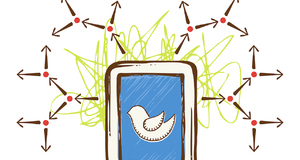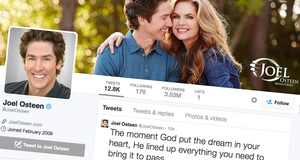From Elon Journal of Undergraduate Research in Communications VOL. 5 NO. 1A Content Analysis of Twitter Use: Factors That Might Increase Music Sales During an Award Show
IN THIS ARTICLE
KEYWORDS
AbstractCan Twitter be used in marketing an artist’s music during award shows? To answer this question, the author examined four artists at the 2013 MTV VMAs—Robin Thicke, Justin Timberlake, Drake, and Kanye West--who experienced a peak of references on Twitter during the show. Based on a content analysis of the tweets and secondary research, the study found that tweets converged toward the same topics, supporting Social Influence Network Theory. This study also found that the director’s filming directions during the award show might also influence the trends on social media during the show. IntroductionSocial media has transformed the way fans interact with their favorite celebrities as well as among one another during award shows. Celebrities now actively tweet before, during, and after award shows as a means of communicating with their fans. Likewise, fans often tend to tweet when their favorite artists perform or win an award at the show. Each year MTV hosts the Video Music Awards (VMAs) during the fall. This award show is one of the biggest productions put on by MTV for the year. The award shows are widely popular in terms of having a social media presence on websites, such as Twitter. According to Time Magazine, 10.1 million people viewed the VMAs this year (Rothman, 2013). Social Guide reported that social media users sent 18,495,883 tweets about the VMAs on the night of the award show (Graver, 2013). The content circulating on social media sites appear to be very influenced by the award show. Subsequently, the artists who performed at the show also experienced an increase in sales of their music on the day of the award and thereafter. MTV reported that Justin Timberlake saw a 1,876 percent increase in Amazon and iTunes sales of his music on the day of the VMAs in comparison to the day prior to the award show. Similarly, Lady Gaga saw a 112 percent increase in sales for her song “Applause,” which she performed at the award show. Other artists who performed at the VMAs also experienced an increase in the sales of their music on the award day and thereafter in comparison to prior days (Rothman, 2013). This paper tried to investigate the relationship between viewers’ tweet activities about artists and increases to their music sales. TheoriesAccording to Friedkin’s Social Influence Network Theory, people have an influence on one another’s thoughts and behaviors in a network (Prell, 2012). This social psychology theory seeks to reflect a dynamic of change that may occur in people as they form and share opinions. It proposes that people “alter their original opinions or behaviors to the group ‘norm’” they follow (Prell, 2012, p. 63). This paper can employ this theory because social media enables people to publicly communicate their opinions and to weigh the popularity of other opinions shared in the same space. If an artist’s music is talked about on social media or trending on Twitter, then other people will become exposed to that music and listen to it or watch the video since it is popular among their peers. Thus, this theory can be employed to check whether social media can be a marketing tool for an artist’s music when TV viewers tweet about the performance during an award show. Uses and Gratifications Theory is also applicable to the analysis of tweets promot-ing pop music artists. This is an audience-based theory that can be used to help explain how consumers – in this case TV viewers – respond to entertainment programming actively via Twitter to satisfy their needs (Rosenberry & Vicker, 2009). More to the point, this theory assists in examining the behavior that fans exhibit as they ‘voice’ their opinions about a performance, the music itself, or simply the phenomena involved with the artist on stage. This subsequently causes more people to learn of the artists’ performances during an award show, since their peers also may be discussing the same event via social media. Uses and Gratification provides a lens from a brand-marketing standpoint, through which to examine how audience members, as they engage as concurrent viewers and commentators, can have effects on the popular successes of the artists and their music. Literature ReviewCunningham (2006) specifically analyzes the MTV VMAs to see how audience engagement with programming influences the effectiveness of advertising during an award show. That study differs from the author’s current research, which examines the impact of Twitter activities on the perception of artists on the show and the subsequent sale of their music on the day of the show. In this regard, this paper analyzes a different aspect of engagement in terms of marketing artists and their music, rather than advertising a product or brand. Cunningham’s study analyzes the forms in which the viewer is engaged; these include the social context, the multi-platform context, and the emotional context of audience engagement. But the techniques used in the study can be applied to this author’s study, which focuses on the analysis of social media engagement in relation to effective marketing techniques for an artist. In analyzing how social media markets to consumers, the role of television in relation to Twitter is important. Multi-tasking is now the norm for people when doing activities such as watching television (Harrington, Highfield, & Bruns, 2013). A common form of multi-tasking while watching television is social media usage. Many television shows have taken full advantage of the social media distraction by integrating the use of social media within their programming. For instance, some television shows now ask their viewers to tweet about the shows or to use specific hashtags that represent the show they are watching. One study analyzed the role of social media with the medium of television (Harrington, Highfield, & Bruns, 2013). The researchers acknowledged that social media, such as Twitter, does not necessarily take away from other media, but rather social media often serves as a complement for media such as television (Harrington, Highfield, & Bruns, 2013). This integration of social media and television is sometimes referred to by the term “social TV” (Proulx & Shepatin, 2012). In their book, Proulx and Shepatin further expanded on the benefits of social media as a complement to television because the two combined provide a more personalized experience for viewers. Learmonth (2009) analyzes the campaign tactics of President Obama during his initial campaign for his first presidency. President Obama’s strategy from the very beginning of his presidential campaign focused on social media to have a large digital media presence (Learmonth, 2009). This tactic resulted in unprecedented rewards for the Obama campaign through its digital media efforts (Learmonth, 2009). This example of brand marketing through social media can be applied in other areas outside of political campaigns. Therefore, this study took an approach to analyzing social media as a marketing tool for a person as a “brand.” Along the line of this concept of branding a person, artists may employ social media in establishing attention for themselves and their music as a brand. Similar to the Learmonth’s (2009) study, Greet and Ferguson (2011) found that news personalities use social media as a means to communicate with their audiences. Based on Uses and Gratifications Theory, Greer and Ferguson (2011) analyzed the motivations, communications, and role of Twitter in the news context through news personalities’ engagement with viewers. Based on this theory, Perrilliat (2012) measured a variety of gratification items in order to assess the use of Twitter and examined how beneficial Twitter is for music fans and consumers. She observed that social networking websites, such as Twitter, have transformed into major outlets for the online consumption of music. Social media is a major necessity for marketing to consumers. It connects brands with the consumers and establishes a direct line of communication between the brand and its consumers (Long, 2012). Long also took into consideration the effects of a lack of communication for a brand. For instance, the research analyzed the engagement of BP with consumers via social media during the 2010 Gulf oil spill. The lack of communication on the part of BP with its consumers negatively influenced the public opinion of BP (Long, 2012). This concept is directly applicable to other subjects, such as whether the engagement with consumers influences the success of the brand. Expanding on the concept of “social TV,” Hill & Benton (n.d.) determined the value TV networks gained by using social media content in relation to their shows. The study identified a value that social media content brings to television shows because online posts via social media increased the “word of mouth” effect. This study also found a high correlation between social media content and television show-related sales. The authors examined the sales effect of viewer engagement with television programming through their analysis of tweets during the television show, The Voice, and the resulting iTunes rankings and sales data. When the author developed the coding scheme for this paper, she looked at another study that used four categories to classify the type of content of the tweets that viewers posted while watching television programming: attention, emotion, information, and opinion (Wohn & Na, 2011). Their study suggests that social media is enabling “group viewing,” in which people can interact about television programming without being in the same room. Following the MTV VMAs, the social media usage during the show was a major topic of discussion, and numerous articles were published reporting the tweets per minute and percentage increases in music sales for each artist. Rothman (2013) reported the percentage increases in sales for each of the artists following their performances. This article, in addition to MTV’s website, provided the sales data needed for this paper. Based on literature review, this study tried to answer the following questions:
MethodsTV viewers posted their tweets during MTV Video Music Award Show on August 25, 2013. First, the author found four artists1 who saw the largest Twitter peaks of tweets per minute (TPM): Miley Cyrus/Robin Thicke with 306,100 TPM , Justin Timberlake with 219,800 TPM, Drake with 194,500 TPM, and Kanye West 181,200 TPM (Graver, 2013). Since the author could not analyze all tweets about these artists, she created a sample of 850 tweets that reflected the ratio of each artist’s TPM. Among 850 tweets, 289 are related to Robin Thicke; 207 to Justin Timberlake; 183 to Drake; and 171 to Kanye West. In the search field of the Twitter homepage, the author wrote keywords, such as #VMA and the four artists’ name, and selected all 850 tweets among those that were posted only when these artists were on the stage. This study tried to categorize all tweets and find the most common categories; the study also tried to find the top categories from tweets about each of the four artists. It also checked whether each tweet is positive or negative toward the artist. A positive tweet was assigned 1 point of the perception score; a negative one, -1 point; a neutral one, 0 point. The positive or negative perception scores and TPM of each artist were compared with the sales increase of their music. FindingsCommon categories of tweetsAnalysis of the sample revealed the 10 most common categories: (see Table 1). To ensure a level of coding objectivity, a second coder examined 85 of the tweets, or 10% of the total. The additional coder was in agreement with approximately 99 percent of the tweets coded in the analysis. Table 1: 10 Common Categories for the Tweets
Categories of tweets about individual artistsAfter determining the 10 most popular categories, the author reanalyzed tweets by artist to see what kinds of tweets were issued about each artist. Kanye WestTop categories of tweets about Kanye West were quality; past actions and behavior; and relationships. There was a common negative sentiment among the tweeters that West’s performance was "autotuned" because tweeters thought that his voice was manipulated electronically for the song. Furthermore, the people tweeting about Kanye West discussed aspects of his past, such as the 2009 VMA incident where West interrupted Taylor Swift’s acceptance speech for her award for video of the year. Many tweets asserted that Swift should interrupt West’s performance. Additionally, the tweets discussed how bizarre it was that West was in the dark during his performance as well as other current things in his life, such as his newborn baby, North West, and his relationship with the Kardashian family. Another topic of controversy within the tweets about West was the title of his new album, “Yeezus.” (Refer to selected tweets about West in Table 2 on next page.) Robin Thicke / Miley CyrusThe tweets about Robin Thicke often included Miley Cyrus as well. The tweets about Robin Thicke emphasized some celebrities’ or viewers’ reactions to aspects of the artist’s performance, such as costumes or dance moves. The other common categories for tweets about Robin Thicke’s include behavior onstage and past relationships. One of the most common trends discussed on Twitter was Robin Thicke’s and Miley Cyrus’ behavior on stage and their costume choices. Thicke was often compared to Beetle Juice, and Cyrus’s wardrobe was criticized for being risqué and similar to the girls in Thicke’s controversial music video for “Blurred Lines.” Also, tweeters offered more of a negative sentiment for Cyrus, rather than Thicke, for “messing up” Thicke’s song as well as her inappropriate dancing. Her behavior was heavily criticized since Thicke is married and quite a bit older. Hence, the tweets about Thicke and Cyrus feature the common categories of reactions, behavior of the artist while onstage, visual features of the performance and relationships. because the tweets often referred to predictions of the reactions of Robin Thicke’s wife and Miley Cyrus’ dad to the performance. Table 2: Sample of Tweets Written About Kanye West
Another common trend for their performance was tweets that simply listed Robin Thicke and Miley Cyrus’ names along with the hashtags for their song names, “We Can’t Stop” and “Blurred Lines.” Additionally, there was a trend in which people asked others for their thoughts on the performance. Therefore, Robin Thicke and Miley Cyrus’ performance was more engaging in the interaction among tweeters while they were watching the award show. (Refer to several tweets about Thicke in Table 3.) Table 3: Sample of Tweets written about Robin Thicke
Justin TimberlakeThe top categories of tweets about Justin Timberlake were quality; expectations and reactions during his performance2; and audience relating to the artist/artist’s Past. Tweets about Timberlake had a heavy emphasis on the quality of his performance, which was expected since he had the most positive of all the Twitter content. Many people wrote that his performance was “the best of the night.” People also used other social media, such as Instagram and Vine in order to document their reactions to the performance within the tweets. There was a major trend in the expectation of the ‘NSYNC performance. There were many tweets about the audience relating to the artist as well as the artist’s past because people were imagining ‘NSYNC performing as “reliving their past.” The audience related to Timberlake on that level because ‘NSYNC was a large part of the audience’s past, through their being fans of the band, but also ‘NSYNC was a major part of Timberlake’s past. So there is a relationship of the audience relating to Timberlake and ‘NSYNC in this regard. (Refer to Table 4 for a sample of tweets about Justin Timberlake.) Timberlake received the most positive responses. Tweets about him focused in the category of the quality of his performance. Additionally, they tended to discuss the hype and expectation of ‘NSYNC performing with Timberlake’s at the award show. This received a lot of positive feedback and showed a lot of support for Timberlake as an artist and for his music. Additionally, it reflected the huge popularity for ‘NSYNC among the VMAs audience base. Table 4: Sample of Tweets written about Justin Timberlake
DrakeThe top three categories of tweets about Drake were reactions; aspects of the artist’s past; and previous relationships. A notable number of tweets about Drake referenced the reactions of other celebrities attending the award show. This emphasized the two categories of previous relationships and reactions to the performance. Many people acknowledged within their tweets that when Rihanna was shown on TV during Drake’s performance that she was giving him “disapproving” and “uninterested” glances. The footage also brought the reactions of the Smith family to the forefront of the tweeters’ attention. Many people suggested that Will Smith and Jaden Smith appeared to be fans of Drake’s. Finally, another common trend in the tweets about Drake addressed how he started out acting on the television show “Degrassi.” This references the category of the artist’s past. Drake’s song, “Started From The Bottom,” stirred some negative tweets because the tweeters felt as though Drake did not “start from the bottom” since he was on a very popular television show as a kid. As can be seen in the sample below, Rihanna’s reaction was a popular trend on twitter. These tweets focusing on Rihanna most commonly fell into both the reactions category as well as relationships category as some of them referenced Rihanna and Drake’s previous relationship. In comparison to the other artists, both Timberlake and Drake had the most references to their past. (Refer to Table 5 for a sample of tweets about Drake.) As for Drake, references in tweets discussed both his and Kanye West’s performances, even though this category of comparison of the artist to other performers did not make the top three categories for Drake. Both Drake and West moved their arms a lot during their performances, and viewers tweeted about this aspect of the artists’ choreography. They did not look upon it too favorably. However, there was still a lot of support for Drake in comparison with West and Thicke’s performances. Table 5: Sample of Tweets written about Drake
Comparison of TPM with music salesThese artists all saw a high peak of tweets per minute during their performances as well as immediate sales increases for their music. Justin Timberlake’s performance featuring ‘NSYNC had approximately 219,800 tweets per minute and a 1,876 percentage increase in sales on the day of broadcast over the previous day. The statistics on the others’ performances are shown in Table 6. Additionally, Miley Cyrus’ album jumped to the number five slot on iTunes for pre-ordered albums since her album wasn’t due to come out until October. Since there was not data available for the percentage increase in sales of Cyrus’ music following her performance, this study focuses on Robin Thicke in the analysis of the tweets during Thicke and Cyrus’ performance. Robin Thicke’s “Blurred Lines” follow-up single, “Give It 2 U” had a 306 percent increase in sales, and his album “Blurred Lines” experienced a 30 percent in sales. For Kanye West’s tweets per minute of 181,200, he saw a very large increase in sales following his performance. His “Blood on the Leaves” single increased in sales by 1,187 percent, and his album “Yeezus” had a 139 percent increase in sales. Drake’s performance had about 194,500 tweets per minute, and he saw a 281 percent increase in sales for his single, “Started From the Bottom,” following his performance. Table 6: Total tweets per minute and percentage increases in sales by artist
Note. * Data from Graver (2013). **Amazon and iTunes sales on the day of the broadcast versus the day before (Rothman, 2013) Comparison of Perception Scores with music salesThe best perception score on average was 1 point if an artist had all positive tweets with each tweet having a score of 1. The worst possible score, with all negative tweets, would be a score of -1 point. Justin Timberlake had the maximum score from tweets about him since all of his tweets had positive connotations. Robin Thicke received the lowest score of the four performances and received a negative score (see Table 7). Table 7: Positive/Negative Perception Score for Each Artist
Suggested Reading from Inquiries Journal
Inquiries Journal provides undergraduate and graduate students around the world a platform for the wide dissemination of academic work over a range of core disciplines. Representing the work of students from hundreds of institutions around the globe, Inquiries Journal's large database of academic articles is completely free. Learn more | Blog | Submit Latest in Business & Communications |



















